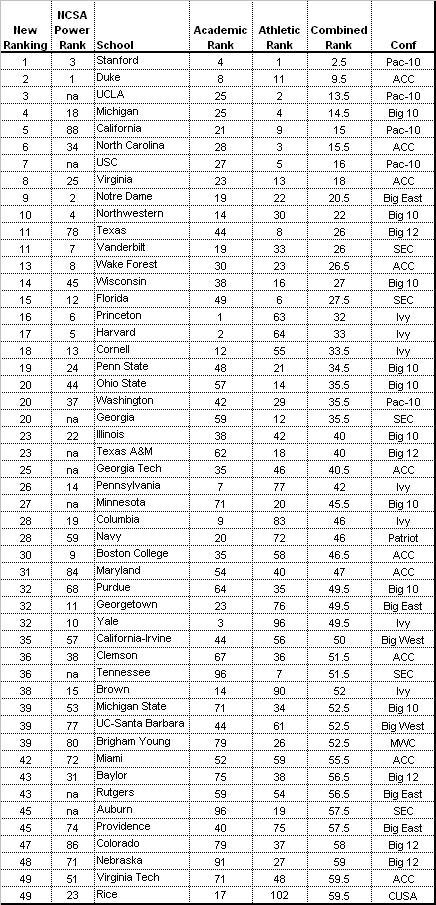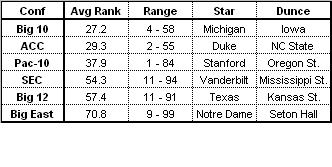2007 Athlademic Ratings – Revised
Posted by rtmsf on September 5th, 2007Ok, so thanks to an insightful UCLA fan, we realized that our exuberant reliance on NCSA data to justify our Athlademic Rankings posted last week was giving them way too much credit for properly vetting their data. So to make sure we get it right this time, we spent the better part of today going through the 2007-08 US News rankings and the 2006-07 Sears Cup rankings ourselves. Here’s the revised list, in Table A.
Table A. Athlademic Ratings – Division I (revised)

New Arrivals. In addition to UCLA and USC, we also see the inclusion of Georgia, Texas A&M, Georgia Tech, Minnesota, Tennessee, Rutgers and Auburn onto our list – all driven by strong athletic programs. High academic schools with relatively weak athletic programs, such as Army, William & Mary and Dartmouth, fell out of the top 50 due to the addition of the above programs.

The Ivies strike a Nice Balance in Athlademics
Ivy League Balance. Speaking of Dartmouth, Keggy the Keg and friends are the only Ivy League school that didn’t make our Top 50. The other seven did, with Princeton (no surprise there) leading the way at #16 overall. Granted, the high academics of the schools drives their inclusion here, but we shouldn’t discount that these schools rate above many larger BCS schools in terms of the success of its athletic programs. Cornell has the 55th most successful athletic program, but there are 73 BCS schools, which means Cornell, Princeton (#63) and Harvard‘s (#64) athletic programs are outperforming bigger state schools such as Kansas (#66), Iowa (#68), and Connecticut (#82).
Big 10 – ACC Challenge. As in, the Big 10 and ACC challenge the rest of the BCS conferences to keep up with it when it comes to athlademics. We rated all 73 BCS conference schools, keeping those ahead of them in place, and Table B below shows the results.
Table B. BCS Conference Athlademic Ratings

Why is the Big East so bad? There’s a pretty clear top tier of Big 10, ACC and Pac-10, a middle tier of the SEC and Big 12, and a bottom tier, where the Big East lurks like Gollum all by itself. The Big East really gets killed on both sides of the equation – it has seven (of 16) third-tier academic schools, as rated by US News (more than the other 5 conferences combined); and seven schools that finished outside of the top 100 in the Sears Cup (Mississippi St. and Kansas St. are the only other two in BCS conferences). This includes the dubious case of Seton Hall, who was the only BCS conference school of the 73 to not score a single point in the Sears Cup competition for 2006-07. How is that possible??

Days Long Since Gone at The Hall
Haves and Have-Nots. The Pac-10 is the greatest example of bifurcation within a conference. It has five of the top twenty athlademic programs in America (Stanford, UCLA, USC, Cal, Washington), but it also only has five of the top fifty programs – its next highest ranked school is Arizona at #51. Compare this with the Big 10, who has nine of its eleven members ranked in the top forty, with only Indiana (#53) and Iowa (#58) weighing it down. Conversely, the Big 12 only has two of its twelve schools ranked in the top forty – Texas (#11) and Texas A&M (#23).
Non-BCS Stars. We already mentioned the Ivies, whose eight schools average a 29.9 rating on our list. But who else steps up to challenge the BCS big boys as an athlademic school? The Naval Academy (#28) and a couple of the smaller UCs (Irvine (#35) & Santa Barbara (#39)) lead the way. One surprise inclusion is our Mormon friends at BYU, who used a strong athletic showing to come in at 39th on our list.
You can do Better. Not to harp on anyone in particular, but it makes no sense to us that football (read: revenue) schools like Cincinnati (#196 in the Sears Cup), South Florida (#133), Mississippi St. (#120), Kansas St. (#111) and Syracuse (#110) can’t do any better with their overall athletic programs. Let’s throw in Villanova (#132) and Marquette (#127) for good measure – both schools are wealthy private Catholic institutions, which means they have the resources to spread around the non-revenue sports. So what’s their excuse?









































